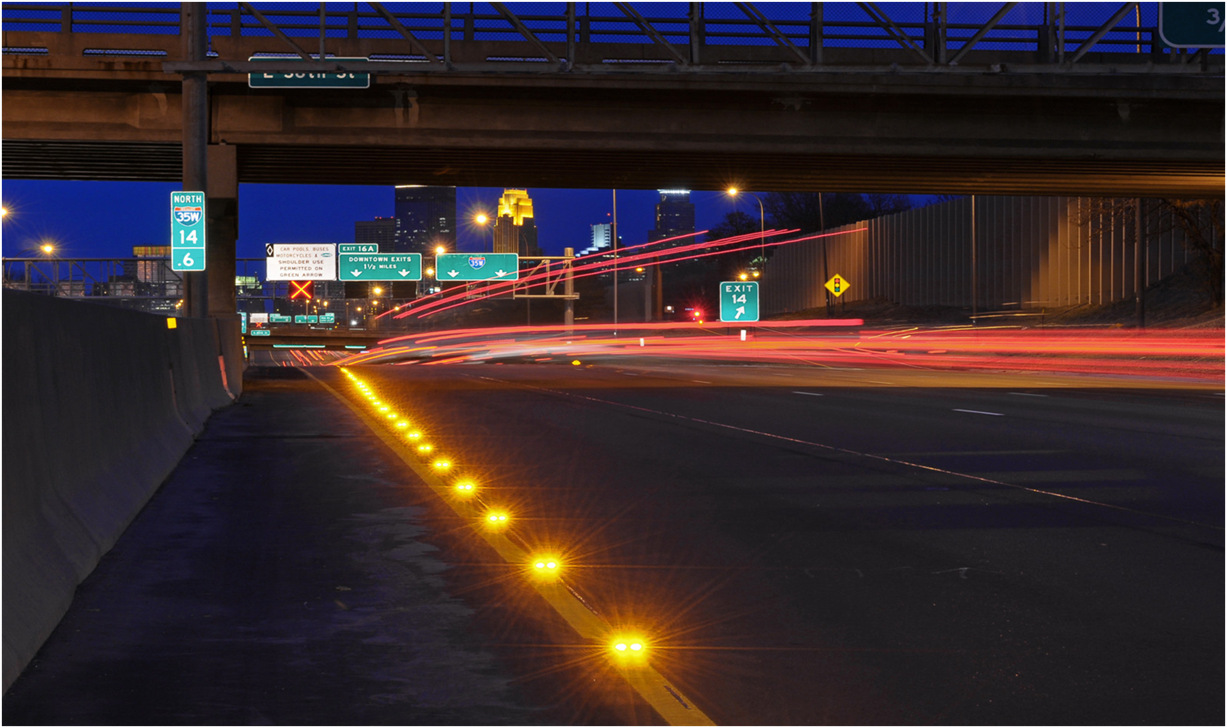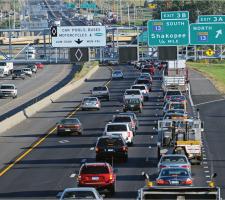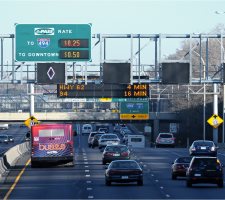
The dynamic shoulder is an important facet of Smart Lanes
Minnesota DoT has built one of the most intensive Active Traffic Management (ATM) systems on the road today. Like many ITS deployments, the state has gained benefits but also faces many challenges, as Pete Goldin reports.
Smart Lanes is the brand name of“Minneapolis and Seattle are the only cities that have deployed full ATM, and we are the only city with a dynamic shoulder HOT lane,” says Brian Kary, freeway operations engineer, MnDoT’s Regional Transportation Management Center (RTMC).
“What first drove us to deploy the ATM system was the dynamic shoulder lane on 35W,” he continues. “We wanted to do a low-cost capacity improvement, and so we added the lane control signals to manage the dynamic shoulder lane, and operate five lanes of traffic in a section that was built for four. After seeing the benefits of the Smart Lanes, we decided to expand ATM to the entire 35W corridor. Our goals are to reduce collisions, improve mobility and increase throughput.”
In addition, the ATM system was expanded to 94, originally to help reroute traffic around the 35W Mississippi River Bridge after it collapsed in 2007. When the bridge reopened in 2008, however, public pressure convinced MnDoT to keep the detour and Smart Lanes operational.
Sign language
MnDoT’s Smart Lanes consist of electronic signs mounted directly over lanes of traffic – spaced approximately a half mile apart – to help motorists make informed decisions. The signs display real-time information about road conditions to improve traffic flow, reduce congestion and improve safety.The system was designed to inform drivers when left lanes are open as HOT (high occupancy toll) lanes; lanes are closed; advisory speed limits are in place; and hazards such as standing water or debris on the roadway are blocking lanes.
The signs are intended to be simple and self-explanatory. For example, a red “X” over the lane indicates that the lane is closed to traffic or has an incident, crash or other obstruction. A green arrow indicates that a lane is open and flowing smoothly. These signs were provided by Addco, which puts MnDoT in an unfortunate situation because the company went out of business in early 2013.
“That is a little bit of a challenge for us, looking forward to our maintenance and operational needs, and getting replacement parts,” Kary notes. “We are trying to figure that out right now.”
Variable speeds
Other components of the ATM system include the many sensors that detect traffic flow and help set the variable speed limits (VSL). About one-third of the detectors are“The loops do not give us speeds as well as the Wavetronix radar sensors,” Kary points out. “We are seeing too much latency with the variable speed limits, because of the loops. We plan to deploy more Wavetronix sensors or other devices because we need better detection methods, so the system will respond faster.” Setting of advisory speed limits is completely automated, computed by an algorithm developed by the RTMC and the University of Minnesota - Duluth. The goal of the advisory VSL system is to mitigate shock wave propagation from downstream bottlenecks by gradually reducing speed levels of incoming traffic flow. Advisory speeds posted on specially designed
signs change by no more than five mph with each change in speed, and can be updated every 30 seconds.
MnDoT is currently researching how to modify advisory speed limits during inclement weather. The VSL system would theoretically utilize rain sensors on the corridor to inform the system about precipitation, and this would impact speed limit changes or possibly even close a shoulder lane. MnDoT is currently conducting research, and will potentially implement this system within the next year.
Some like it HOT
The other important facet of the Smart Lanes is the dynamic shoulder, a necessary feature because the physical width of the highway on 35W northbound from 42nd Street to downtown limits the number of lanes. The ATM system enables the far left shoulder to be used as an actual traffic lane when the capacity is needed, and remain a shoulder at all other times. In fact, the shoulder becomes part of the dynamically priced MnPass HOT lane.“The MnPass lane to the north had to stop about three miles shy of downtown Minneapolis,” Kary explains. “We saw it was going to create a major bottleneck. The dynamic shoulder lane provided a way that we could extend that MnPass lane into downtown.”
MnDoT had future plans to rebuild that last three miles of highway to make room for a HOT lane, but that was not scheduled until in the mid-2020s. It was estimated to cost as much as $500 million, but instead MnDoT was able to build the dynamic shoulder lane in 2009 for $17 million.
“We were able to extend the MnPass lane 15 years earlier, and at a fraction of the cost,” Kary states. “That is what really drove the idea of active traffic management.”
A diamond is displayed over the shoulder, as well as the regular HOT lane, when it is open, and a red “X” appears over the shoulder at all other times. Another set of signs displays the current rate for a solo driver to use the HOT lane. These rates update every three minutes based on real-time demand for the HOT lane.
“We reduce the price to encourage more use, and increase the price to get people out of there so we can continue to keep traffic flowing at 50 mph,” says Kary.
Everything is controlled by MnDoT’s freeway traffic management software, called Intelligent Roadway Information System (IRIS), an open source software developed in-house and available to any transportation agency.
The main benefit MnDoT has achieved from the Smart Lanes is a low-cost capacity improvement – the ability to increase highway capacity by activating the dynamic shoulder during peak traffic.
Mixed results
Surprisingly, although the ATM system was modelled on similar systems in Europe that have been proven effective at reducing collisions and improving traffic flow, these other expected benefits have not materialized for MnDoT.“In terms of the variable speed limits, we are not seeing a huge increase in throughput at all,” Kary admits. “It is still too early to tell if there will be safety improvements.”
Kary attributes the lack of tangible mobility improvement, from variable speed limits, to the possibility that MnDoT already squeezed out all the available capacity through its extensive ramp metering system.
“During incidents, we are finding that compliance is not as good as we would have hoped,” Kary says. “We are doing a study right now with the University of Minnesota to monitor how traffic responds to the signs. But anecdotally, we are seeing that not too many drivers actually move out of the lane with a red “X”. I think the best we can hope for is that they are paying a little more attention.”
Ironically, during studies using a computer simulation, MnDoT saw 90+ per cent compliance with the signs. But that level of compliance is not translating to the real world.
“We are trying to figure out how we can improve that,” Kary says. “I think a lot of it is going to be driver perception of the value of the sign. I don’t think it is about misunderstanding. It is more about how they utilize the information once they get it. The solution still remains to be seen.”
With this in mind, MnDOT has no major plans to expand the ATM system. Kary says they are taking a step back and analysing the performance, especially due to the high cost of operations and maintenance on the 300 signs currently in use. For example, MnDoT’s annual maintenance agreement for the ATM system on 35W cost $300,000 and utility costs are $60,000 per year.
MnDoT is looking at one possible expansion to the ATM system, a MnPass lane on 35E, north of downtown St. Paul. MnDoT opted for a minimal number of signs this time.
“We are dubbing it Active Traffic Management Lite, because it is not going to be quite intensive,” Kary concludes.













